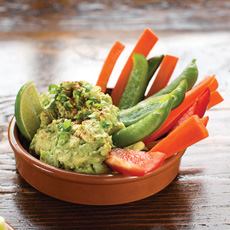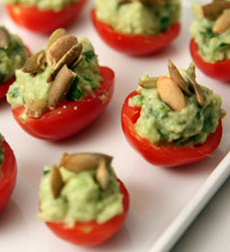|
November 14th is National Spicy Guacamole Day. If you don’t like heat, regular National Guacamole Day is September 16th.
Most people make guacamole to taste, adding crushed red chile flakes, some hot sauce, or minced jalapeños.
But you can use different types of heat, all of which provide slightly different nuances to the heat.
You can also use these seasonings to celebrate January 16th, International Hot & Spicy Food Day, and August 19th, National Hot & Spicy Food Day.
HOW TO ADD HEAT:18 WAYS TO SPICE UP GUACAMOLE
1. HOT MIX-INS
Add more heat in your favorite forms. You can divide the batch to test your preferences.
Alpeppo pepper: Crushed red crushed flakes from Syria (and to a lesser extent, Turkey) with a deep, rich aroma some compare to ancho, plus a sweet fruitiness. More.
Cayenne and/or red chili flakes: The longstanding classics.
Gochujang: A pungent and savory condiment made from fermented soy beans and red chili peppers. It is traditionally used to season Korean foods like kimchi. More.
Harissa: A paste typically made from various dried red chili peppers, cumin, coriander, caraway seeds and garlic. More.
Hot mustard: A hotter mustard, like Chinese mustard. Look for Colman’s in powder or prepared mustard.
Hot oil: chile-infused oil and mustard oil are two options. Alternatively, you can drizzle them on top of the bowl as a garnish.
Hot sauce: Note that more than a few drops of red hot sauce will darken the guacamole. If you want to use a lot, look for a green hot sauce, made from green chiles.
Jalapeño, habanero or other hot chile: Use green to blend in or red for contrast (red chiles have more heat). Mince them.
Onions: White onions are the hottest, followed by red onions. Mince them.
Prepared white horseradish: Save the red for a garnish.
Sriracha: A hot sauce that originated in Thailand, made from chili peppers, distilled vinegar, garlic, salt and sugar. More.
Wasabi: Paste or powder, this relative of western horseradish, from Japan, adds heat without prominent horseradish flavor. More.
2. SPICY TOPPINGS/GARNISHES
Horseradish: Grated fresh horseradish or prepared red horseradish, which is white horseradish colored with beets. It makes a bright rim around the surface perimeter of the bowl.
Microgreens: arugula or mustard.
Radishes: a fine dice.
Red horseradish: From a bottle of prepared horseradish.
Spicy pumpkin seeds: Make your own or buy SuperSeedz in Somewhat Spicy or Super Spicy.
Szechuan peppercorns: The tingling sensation has a slow onset and lingers for a long time. Crush it as a garnish. Szechuan peppercorn is not a true peppercorn, but a member of the citrus family typically. More. Here are the different types of pepper.
BEYOND TORTILLA CHIPS: WAYS TO SERVE GUACAMOLE
Before it became a dip with tortilla chips, guacamole was an all-purpose sauce (see the History Of Guacamole in the next section). Today, you have a broad choice of how to use it, beyond Tex-Mex, with:
Anything grilled
Avocado toast (with or without a fried egg) or omelet filling
Baked potatoes
Burger topping (photo #4 above)
Chicken salad: blend with mayonnaise
Cobb salad, instead of sliced avocado
Condiment/topping for fish
Deviled eggs
Flatbread: with any topping from arugula and bacon to sliced hard-boiled eggs
Guacamole mayonnaise: half and half, or however you like it
Hot dog topping
Hummus: ditto
Mayonnaise substitute
Pizza: instead of tomato sauce, topped with bell pepper, cherry tomatoes, corn, jalapeño, red onion, chicken, whatever
Sandwich spread: on a BLT, ham, turkey, veggie or other favorites sandwich
Stacked appetizer: alternate with layers of salmon or tuna tartare (photo #3 above)
Stuffed mushrooms
|
|

[1] Spicy guacamole with crudités (photo © Hannah Kaminsky | Bittersweet Blog).

[2] Guacamole-stuffed cherry tomatoes (photo © Frontera Fiesta).

[3] Spicy guacamole under tuna tartare (photo © Chicago Cut Steakhouse).

[4] Burger with guacamole (photo © The Organic Grill).

[5] Guacamole-tuna hors d’oeuvre (photo © Ippudo | NYC).

[6] Avocados on the tree (photo © Avocados From Chile).
|
|
Tortilla chip alternatives: Japanese black sesame rice crackers, Swedish flatbread like Wasa crispbread
THE HISTORY OF GUACAMOLE
Mesoamericans cultivated the avocado, a fruit which had grown in the area for millions of years. The conquering Aztecs called it ahuacatl (ah-ha-kwa-tay); the “tl” is pronounced “tay” in Nahuatl, the Aztec language.
Ahuacatl means “testicle.” Aztecs saw the avocado as resembling testicles and ate them as a sex stimulant.
When the Spanish conquistadors arrived in 1519 under Hernán Cortés, they heard the word as aguacate, ah-hwah-cah-tay, the spelling and pronunciation they adopted. The sauce made from it evolved into was ahuacamOlli, a compound of ahuacatl [avocado] + mOlli [sauce].
Guacamole was compounded in a molcajete, a mortar and pestle carved from volcanic stone.
According to Linda Stradley on the website WhatsCookingInAmerica.com, for centuries after Europeans came into contact with the avocado, it carried its reputation for inducing sexual prowess. It wasn’t purchased or consumed by anyone concerned with his or her reputation.
American avocado growers had to sponsor a public relations campaign to dispel the myth before avocados could become popular. After then, their dark green, pebbly flesh also earned avocados the name, “alligator pear.”
CHECK OUT WHAT’S HAPPENING ON OUR HOME PAGE, THENIBBLE.COM.
|








